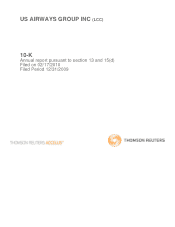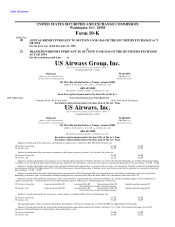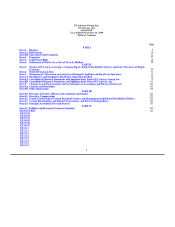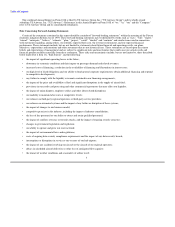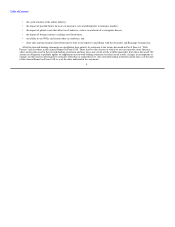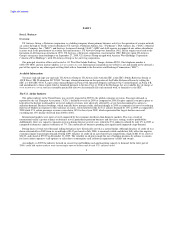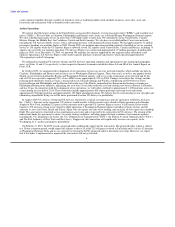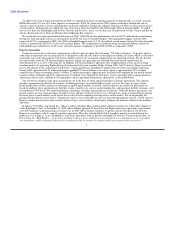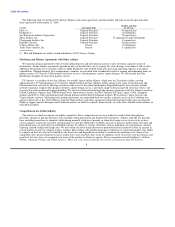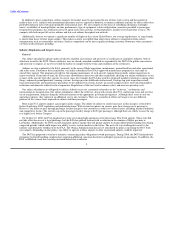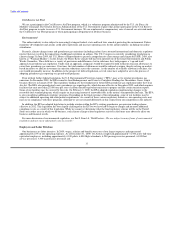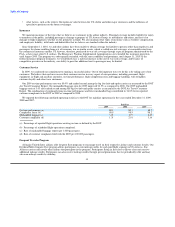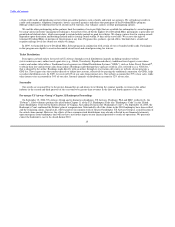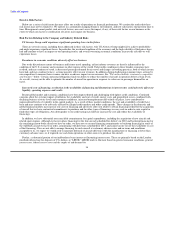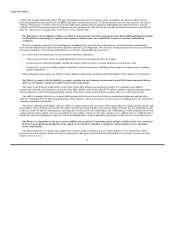US Airways 2009 Annual Report Download - page 9
Download and view the complete annual report
Please find page 9 of the 2009 US Airways annual report below. You can navigate through the pages in the report by either clicking on the pages listed below, or by using the keyword search tool below to find specific information within the annual report.
Table of Contents
To address the weak revenue environment in 2009, we continued to focus on matching capacity to demand and, as a result, our total
RPMs decreased 4.2% on 4.5% lower capacity as compared to 2008. We achieved our 2009 capacity reductions through the sale of
aircraft, return of aircraft to lessors and reductions in aircraft utilization. Despite the capacity reductions in 2009, we increased service in
certain markets. Domestically, we added new non-stop service from our Charlotte hub to Honolulu, Hawaii. Internationally, we added
new service from our Philadelphia hub to Oslo, Norway and Tel Aviv, Israel, service from our Charlotte hub to Paris, France and Rio de
Janeiro, Brazil and service from our Phoenix hub to Montego Bay, Jamaica.
We continued our strong operational performance in 2009. Our 2009 on-time performance rate was 80.9% and ranked second among
the big five hub-and-spoke carriers as measured by the DOT Air Travel Consumer Report. Our mishandled baggage ratio for 2009
improved 36.5% as compared to 2008. Our 2009 mishandled baggage ratio of 3.03 also ranked second among the big five hub-and-spoke
carriers as measured by the DOT Air Travel Consumer Report. The combination of continued strong on-time performance and fewer
mishandled bags contributed to 34.8% fewer reported customer complaints to the DOT in 2009 as compared to 2008.
Express Operations
Certain air carriers have code share arrangements with us to operate under the trade name "US Airways Express." Typically, under a
code share arrangement, one air carrier places its designator code and sells tickets on the flights of another air carrier, which is referred to
generically as its code share partner. US Airways Express carriers are an integral component of our operating network. We rely heavily
on feeder traffic from our US Airways Express partners, which carry passengers to our hubs from low-density markets that are
uneconomical for us to serve with large jets. In addition, US Airways Express operators offer complementary service in our existing
mainline markets by operating flights during off-peak periods between mainline flights. During 2009, the US Airways Express network
served 152 airports in the continental United States, Canada and Mexico, including 75 airports also served by our mainline operation.
During 2009, approximately 27 million passengers boarded US Airways Express air carriers' planes, approximately 42% of whom
connected to or from our mainline flights. Of these 27 million passengers, approximately 8 million were enplaned by our wholly owned
regional airlines Piedmont and PSA, approximately 19 million were enplaned by third-party carriers operating under capacity purchase
agreements and less than 1 million were enplaned by carriers operating under prorate agreements, as described below.
The US Airways Express code share arrangements are in the form of either capacity purchase or prorate agreements. The capacity
purchase agreements provide that all revenues, including passenger, mail and freight revenues, go to us. In return, we agree to pay
predetermined fees to these airlines for operating an agreed-upon number of aircraft, without regard to the number of passengers on
board. In addition, these agreements provide that certain variable costs, such as airport landing fees and passenger liability insurance, will
be reimbursed 100% by us. We control marketing, scheduling, ticketing, pricing and seat inventories. Under the prorate agreements, the
prorate carriers receive a prorated share of ticket revenue and pay certain service fees to us. The prorate carrier is responsible for pricing
the local, point to point markets to the extent that we do not have competing existing service in that market. We are responsible for
pricing all other prorate carrier tickets. The prorate carrier is also responsible for all costs incurred operating the aircraft. All US Airways
Express carriers use our reservation systems and have logos, service marks, aircraft paint schemes and uniforms similar to our mainline
operation.
In January 2010, Mesa Air Group Inc. ("Mesa") and its subsidiary Mesa Airlines filed voluntary petitions for relief under Chapter 11
of the Bankruptcy Code. At December 31, 2009, Mesa Airlines operated 53 aircraft for our Express passenger operations, representing
over $450 million in annual passenger revenues to us in 2009. Mesa Airlines continues to operate aircraft on behalf of US Airways
Express in accordance with its capacity purchase agreement. Mesa has stated publicly that it intends to operate as normal during the
pendency of its Chapter 11 case, including its code share agreements with its partners including US Airways. For more discussion, see
Part 1, Item 1A, "Risk Factors — If we incur problems with any of our third-party regional operators or third-party service providers,
our operations could be adversely affected by a resulting decline in revenue or negative public perception about our services."
7

